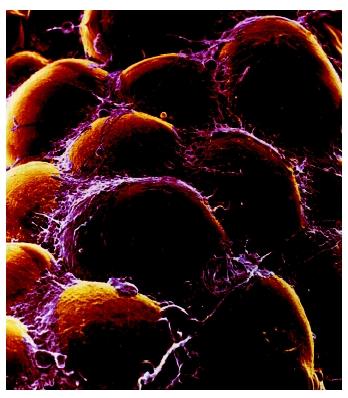
Adipose tissue is a form of loose connective tissue that is found in most parts of the body in two forms, brown adipose tissue and white adipose tissue, which will be the concentration of this work. This tissue arises from cells called pre-adipocytes (not yet filled with lipids), and then with the incorporation of lipid molecules they become true adipocytes (Albright, 1998). Adipose tissue is not richly vascularized with at least one capillary in contact with each adipocyte, which provides enough energy for metabolic processes and functioning of the cell. Adipose cells are characterized by a large droplet of fat in the middle of the cell which pushes the nucleus and cytoplasm to the edge of the cell, which gives the cell a characteristic white appearance.
The main functions of this tissue are to provide mechanical cushioning, insulation and most importantly it serves as a fat storage unit that provides energy to the body. Adipose tissue packs together very well, and it is for this reason that it acts as a good mechanical cushion (Albright, 1998). As a connective tissue it is often found on the surfaces and also throughout the insides of organs so it can provide an extra layer of protection against the abrasive nature of day to day life. The adipose also acts as a thermal insulator which provides a great deal of hear retention allowing the body to remain functional at decreased ambient temperatures. However its most important function is to act as an energy store providing the body with a readily available source of energy that does not require the retention of water for storage which means that more energy can be stored without adding excessive water weight (Wikipedia, 2008) .
One of the major pathologies that arises from adipose tissue is obesity, which results from the increased storage of lipids in the a
 dipocytes. As more lipids are consumed the body stores more lipids, resulting in an increase in the size of the adipocytes in the body and with a an almost unlimited ability to store lipids this can lead to dangerous amounts of fat being stored. The result of this can be hazardous, leading to many obesity related diseases including heart and liver diseases ( American Heart Association, 2008).
dipocytes. As more lipids are consumed the body stores more lipids, resulting in an increase in the size of the adipocytes in the body and with a an almost unlimited ability to store lipids this can lead to dangerous amounts of fat being stored. The result of this can be hazardous, leading to many obesity related diseases including heart and liver diseases ( American Heart Association, 2008).Adipose tissue. (2008, February 27) http://en.wikipedia.org/wiki/Adipose_tissue
Albright, A.L. and Stern, J.S. (1998). Adipose tissue. In: Encyclopedia of Sports Medicine and Science, T.D.Fahey (Editor). Internet Society for Sport Science: http://sportsci.org. 30 May 1998.
American Heart Association. Accessed March 2, 2008. http://www.americanheart.org/presenter.jhtml?identifier=4639
No comments:
Post a Comment